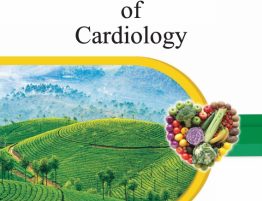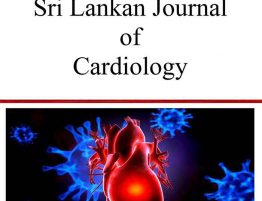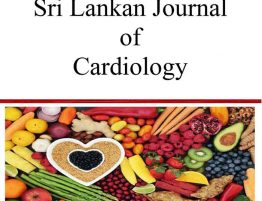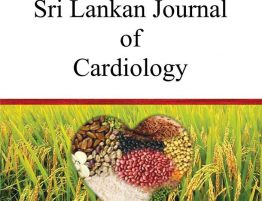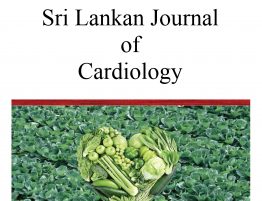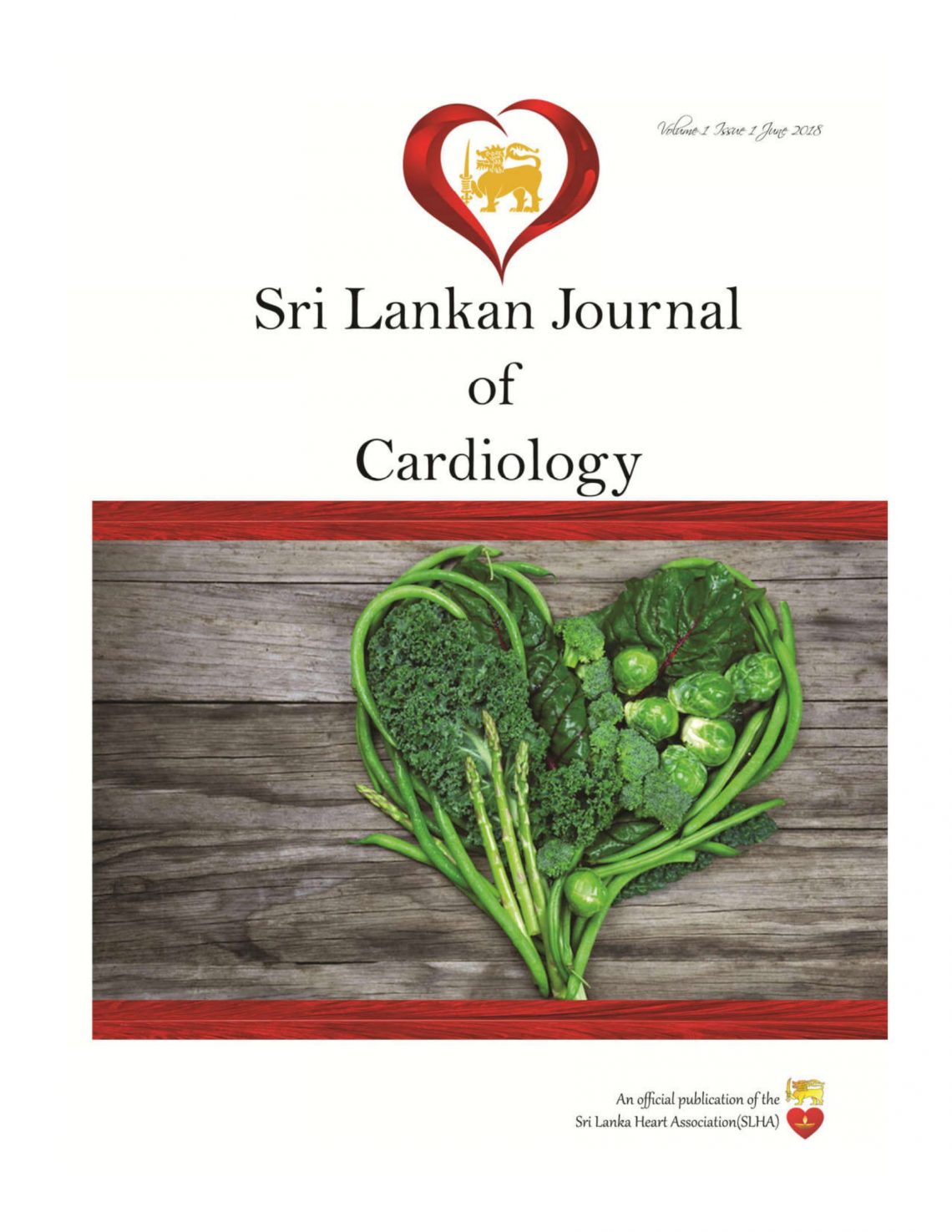
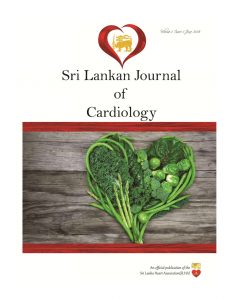
Sri Lankan Journal of Cardiology – Volume 1 Issue 1, June 2018
Abstract
Resistant hypertension could be defined as blood pressure that remains elevated despite being treated with 3 anti-hypertensives of which one is a diuretic at maximum tolerable dose. It is an important global health issue associated with morbi dity and mortality. It is a relatively common clinical problem. It is commonly associated with old age, obesity, sleep apnoea, and ch ronic kidney disease.A number of pathophysiological mechanisms are involved in resistant hypertension. Imbalance in sympathetic nervous system and renin-angiotensin system, excess sodium intake, disturbances between vasoconstrictors and vasodilators and wall resistance are other mechanisms involved in the pathogenesis. In the management life style modification such as weight loss, exercise and salt restriction has to be strictly enforced. If underlying cause is found it has to be treated. The initial preferred multidrug regime includes a diuretic,angiotensin – converting enzyme inhibitor or angiotensin II receptor blockers and long-acting calcium channel blockers. If this initialoptimization of drugs is not effective a mineralocorticoid receptor antagonists can be added.Despite the use of several antihypertensive a substantial proportion of patients with resistant hypertension remain uncontrolled. This has necessitated the testing of devices in the treatment of resistant hypertension. Two new approaches, carotid Baroreflex Activation Therapy and renal sympathetic denervation have shown some promise in the preliminary studies.
Original Articles
-
Anomalous Origin Of Coronary Vessels With Normal Angiographic Appearance- Is It Always Benign ?
Anomalous Origin Of Coronary Vessels With Normal Angiographic Appearance.Is It Always Benign ?
Abstract
 The embryological origin and aberrations in the development of coronary vessels can result in interesting variations which are known as coronary artery anomalies (CAA). The incidence of these anomalies though thought to be low (0.3% to 5.6%,), can have clinically significant implications when present. The scope of understanding the complexity of CAA far exceeds this brief presentation and is better understood by the comprehensive review given by Villa et al.[1]. 2014 ACC/AHA Guideline on NSTEMI /UA
The embryological origin and aberrations in the development of coronary vessels can result in interesting variations which are known as coronary artery anomalies (CAA). The incidence of these anomalies though thought to be low (0.3% to 5.6%,), can have clinically significant implications when present. The scope of understanding the complexity of CAA far exceeds this brief presentation and is better understood by the comprehensive review given by Villa et al.[1]. 2014 ACC/AHA Guideline on NSTEMI /UAAuthor :- Navinan M. R
Download| PDF (EN) (340 KB)
-
Sri Lankan Journal of Cardiology
-
Liitor atorvastatin calcium tablets
Liitor atorvastatin calcium tablets
Abstract

The healthy heart. At the end, we are what we eat. An ever changing and rapidly evolving society has made us abandon the healthy dietary practices which was once both tradition and the norm…
Download | PDF (EN) (280 KB)
-
SLJC Editorial Board
SLJC Editorial Board
Abstract

The scope of this journal will be broadly based in order to realize three objectives…
Download | PDF (EN) (280 KB)
-
Message from the Team
-
Diagnosis, evaluation and treatment of resistant hypertension
Diagnosis, evaluation and treatment of resistant hypertension
Abstract

Resistant hypertension (RHYT) is an important global health problem. It is associated with severe target organ damage. Patients with RHYT usually have a combination of other co-morbid conditions such as obesity, diabetes and chronic kidney disease that further elevate the risks of morbidity and mortality…
Author :- Constantine G.R.
Download | PDF (EN) (416 KB)
-
Outline of Cardiovascular effects of antidiabetic agents from clinical trials and comparative study data
Outline of Cardiovascular effects of antidiabetic agents from clinical trials and comparative study data
Abstract

One of the major objectives of treating diabetes mellitus would be to prevent life threatening or disabling coronary, cerebral or peripheral vascular disease. Unfortunately the currently available antidiabetic drugs, in the large measure, have sparse evidence of benefit in this regard…
Author :- Ruvan A.I. Ekanayaka
Download | PDF (EN) (388 KB)
-
Diagnostic performance of four different screening tools in detecting pre-diabetes and diabetes
Diagnostic performance of four different screening tools in detecting pre-diabetes and diabetes
Abstract

The pandemic of diabetes is rapidly spreading in South Asia including Sri Lanka [1]. Due to the asymptomatic nature in the early phase of the disease, a substantial majority of individuals affected with type 2 diabetes (T2DM) remain undiagnosed until they develop debilitating and fatal complications such as blindness, end stage renal disease or premature cardiovascular disease…
Author :- Weerarathna T.P.
Download | PDF (EN) (436 KB)
-
Prevalence of resistance to aspirin and clopidogrel in patients
Prevalence of resistance to aspirin and clopidogrel in patients
Abstract

Atherothrombotic cardiovascular disease is an important category of non-communicable disease which causes significant morbidity and mortality in all societies in the modern world. Antiplatelet therapy, of which aspirin is most widely used, is an essential component of pharmacologic therapy given to patients with atherothrombotic disease. In recent times it has been the practice of many clinicians to use a combination of antiplatelet agents which have different modes of action…
Author :- Ruvan A.I. Ekanayaka
Download | PDF (EN) (504 KB)
-
Correlation of fish consumption and the Omega-3 index in healthy free living Sri Lankan subjects
Correlation of fish consumption and the Omega-3 index in healthy free living Sri Lankan subjects
Abstract

Atherothrombotic cardiovascular disease is an important category of non-communicable disease which causes significant morbidity and mortality in all societies in the modern world. Antiplatelet therapy, of which aspirin is most widely used, is an essential component of pharmacologic therapy given to patients with atherothrombotic disease. In recent times it has been the practice of many clinicians to use a combination of antiplatelet agents which have different modes of action…
Author :- Ruvan A.I. Ekanayaka
Download | PDF (EN) (624 KB)
-
Changing landscape of STEMI care in Sri Lanka
Changing landscape of STEMI care in Sri Lanka
Abstract

Timely reperfusion therapy is the cornerstone in the management of ST segment elevation myocardial infarction (STEMI). Both European and American guidelines recommend primary percutaneous coronary intervention (PCI) as the preferred method of treatment for STEMI when the anticipated PCI related time delay is less than 120 minutes from the time of STEMI diagnosis…
Download | PDF (EN) (476 KB)
-
Registry data A preliminary report on Head up Tilt testing
Registry data A preliminary report on Head up Tilt testing
Abstract

Transient loss of consciousness (TLOC)[1] is a common indication for being referred to Cardiology team. Proper assessment of such a patient encompasses most importantly a detailed history[2] followed by focused examination and relevant investigations to delineate the cause…
Author :- De Vas Goonewardane A.P.N.
Download | PDF (EN) (324 KB)
-
Cardiac rehabilitation in Sri Lanka
Cardiac rehabilitation in Sri Lanka
Abstract

Sri Lanka is proud to say it has been providing free health care, within a heritage of a national health care system of 150 years. Having a sprawling complex of buildings dedicated to healthcare, cardiology has its own dedicated unit, “The Institute of Cardiology” along with its cardiothoracic wards and theatres. Since becoming functional the objective has been to provide holistic and up-to-date cardiac care…
Author :- Mendis S.A.E.S.
Download | PDF (EN) (476 KB)
-
Rapid scan of scientific papers
Rapid scan of scientific papers
Abstract

Kwong et al [1]reported in the NEJM Jan 2018 that there was a significant association between respiratory infection and subsequent acute myocardial infarction. This was especially true for influenza. The risk seemed to be restricted to within 7 days of a positive laboratory result for influenza. There was no increased incidence after seventh day…
Author :- Editorial desk
Download | PDF (EN) (296 KB)
-
Practice Points from Late Breaking Clinical trials
Practice Points from Late Breaking Clinical trials
Abstract

This trial attempts to answer the doubts regarding the safety and efficacy of converting to ticagrelor in patients already on clopidogrel after thrombolysis…
Author :- Editorial desk
Download | PDF (EN) (264 KB)
-
Ten key messages from the 2018 ESC
Ten key messages from the 2018 ESC
Abstract

The following are key points to remember from the 2018 European Society of Cardiology (ESC) Guidelines for the Diagnosis and Management of Syncope…
Author :- Editorial desk
Download | PDF (EN) (264 KB)
-
Updates from Translational Science
Updates from Translational Science
Abstract

Histones are proteins which are present in the cell nucleus, helping to package nuclear DNA into nucleosomes. Tails of histones protrude out of the nucleosome core and are susceptible to acetylation and deacetylation. These processes are thought to be important in gene regulation…
Author :- Editorial desk
Download | PDF (EN) (220 KB)
-
NOACs
NOACs
Abstract

What does NOAC stand for? Non Vitamin K antagonist Oral Anti Coagulants…
Author :- Editorial desk
Download | PDF (EN) (240 KB)
-
Scimitar syndrome: A rare cause of right sided palpitations in an adult
Scimitar syndrome: A rare cause of right sided palpitations in an adult
Abstract

Scimitar syndrome is a rare, congenital, cardio-pulmonary defect presenting as an anomalous right pulmonary vein draining directly into the IVC, in association with a hypoplastic right lung, a hypoplastic right pulmonary artery, with a resultant shift of the mediastinum into the right hemi thorax, with or without an anomalous systemic arterial supply to the right lung…
Author :- Perera I.A.
Download | PDF (EN) (428 KB)
-
Device closure of left atrial appendage as a modality for stroke prevention in a patient with atrial fibrillation- the first in Sri Lanka
Device closure of left atrial appendage as a modality for stroke prevention in a patient with atrial fibrillation- the first in Sri Lanka
Abstract

Atrial fibrillation (AF) is the most common significant cardiac arrhythmia, affecting more than 33 million individuals worldwide [1] with a high prevalence in western populations. It’s prevalence in Asian populations is low (< 1%), although it increases with age [2]. The number of patients with AF is expected to rise 2-5-fold in following decades [3] due to the growing population of older adults…
Author :- Mendis S.A.E.
Download | PDF (EN) (536 KB)
-
Management of a difficult case scenario with left anterior descending artery (LDA) chronic total occlusion (CTO) in the setting of limited resources
Management of a difficult case scenario with left anterior descending artery (LDA) chronic total occlusion (CTO) in the setting of limited resources
Abstract

A Chronic Total Occlusion (CTO) is defined as a 100% occlusion in a coronary artery with Thrombolysis in Myocardial Infarction (TIMI) 0 flow i.e (no antegrade flow beyond the occlusion) of at least three months duration [1]. Incidence of coronary CTOs are reported to be as high as 20% in usual practice…
Author :- Amarasekera H.S.U.
Download | PDF (EN) (448 KB)
-
Anomalous left main coronary artery (LMCA) arising from right coronary cusp: A case report
Anomalous left main coronary artery (LMCA) arising from right coronary cusp: A case report
Abstract

Coronary artery anomalies represent a potentially fatal form of congenital cardiac pathology. Although rare in incidence, they constitute a diverse group of anatomic variants with variable presentations and clinical impact. Anomalous origination of a coronary artery from the opposite coronary sinus is a subgroup with high risk for sudden cardiac death…
Author :- Ranasinghe R.B.D.
Download | PDF (EN) (252 KB)
-
Large coronary arteriovenous fistula presenting with infective endocarditis and regurgitation of the aortic valve – an atypical presentation of a rare condition
Large coronary arteriovenous fistula presenting with infective endocarditis and regurgitation of the aortic valve – an atypical presentation of a rare condition
Abstract

Coronary arteriovenous fistula is a rare anomaly, which by definition involves a sizable communication between a coronary artery and one of the four cardiac chambers or a segment of either the pulmonary or systemic vasculature, bypassing the myocardial capillary bed [1,2]. This usually occurs in isolation and is found in approximately 0.002% of the general population…
Author :- Bandarage P.
Download | PDF (EN) (444 KB)
-
Transcatheter closure of symptomatic aortopulmonary window using an Amplatzer type atrial septal occluder
Transcatheter closure of symptomatic aortopulmonary window using an Amplatzer type atrial septal occluder
Abstract

Aortopulmonary window (APW) is a communication between ascending aorta and the pulmonary trunk, occurring above the semilunar valves. Isolated APWs account for 0.2% of cases of congenital heart diseases[1] and is associated with other cardiac anomalies in 52% of cases…
Author :- Sooriyasena J.A.G.P.
Download | PDF (EN) (512 KB)
-
Intra ventricular septal haematoma and acquired ventricular septal defect following blunt chest trauma
Intra ventricular septal haematoma and acquired ventricular septal defect following blunt chest trauma
Abstract

Violent blunt chest trauma is reported to cause a wide range of cardiovascular injuries depending on its mechanism [1]. Septal haematoma and acquired ventricular septal defect (VSD) are rarely reported as complications following blunt chest trauma in survivors following such injuries[2]. It is natural to pay less attention and to concentrate on other more apparent injuries in such a patient [3]. However, early detection and timely planned appropriate intervention are extremely important for the survival of these patients with significant cardiac trauma…
Author :- Bandara H.G.W.A.P.L.
Download | PDF (EN) (600 KB)
-
A case of delayed presentation of post-traumatic mitral regurgitation and VSD following penetrative cardiac injury
A case of delayed presentation of post-traumatic mitral regurgitation and VSD following penetrative cardiac injury
Abstract

Penetrating cardiac traumata are life threatening injuries in which only a minority of patients will survive to reach the hospital. In the emergency situation the challenge to the surgeon is basically to keep the patient alive following a ‘damage control’ strategy. There can be residual intracardiac injuries, easily overlooked by the operator as these might not be endangering life in the emergency situation…
Author :- Bandarage P.
Download | PDF (EN) (368 KB)
-
Where is the culprit A case of infero-posterior STEMI due to occlusion of a dominant circumflex artery of anomalous origin
Where is the culprit A case of infero-posterior STEMI due to occlusion of a dominant circumflex artery of anomalous origin
Abstract

Anomalous origin of the circumflex artery from the right sinus of Valsalva or right coronary artery is one of the commonest coronary artery anomalies. It may be missed on the coronary angiogram unless carefully looked for, bearing in mind the clinical profile of the patient. In performing coronary angioplasty in such a vessel, numerous technical obstacles may need to be overcome to achieve a successful result…
Author :- Colombage D.D.E.
Download | PDF (EN) (388 KB)
-
Management of a case of dynamic (intermittent) severe ischaemic mitral regurgitation
Management of a case of dynamic (intermittent) severe ischaemic mitral regurgitation
Abstract

Mitral regurgitation (MR) can be classified as primary and secondary. Primary MR is usually due to an organic disease of the mitral valve (MV) itself especially involving the mitral valve leaflets. Secondary MR is usually due to dilatation of the mitral annular ring following LV remodeling in cases of cardiomyopathy or myocardial ischaemia affecting the functionality of the MV. The mechanism of ischaemic MR(IMR) is a complex phenomenon…
Author :- Amarasekera H.S.U.
Download | PDF (EN) (372 KB)
-
A challenging case of heavily calcified unprotected left main coronary artery (LMCA) distal critical stenosis treated with rotational atherectomy and drug eluting stent (DES) placement
A challenging case of heavily calcified unprotected left main coronary artery (LMCA) distal critical stenosis treated with rotational atherectomy and drug eluting stent (DES) placement
Abstract

LMCA disease accounts for 5-10% of angiographic results and unprotected LMCA disease treated medically has a 3 year mortality rate of 50%. Coronary artery bypass grafting (CABG) is considered the gold standard therapy for LMCA disease. The development of coronary stents, particularly drug eluting stents, with their dramatic patency improvement powered by antiplatelet regimens warrants reconsideration of Percutaneous coronary intervention (PCI) as a successful treatment option for LMCA disease…
Author :- Amarasekera H.S.U.
Download | PDF (EN) (616 KB)
-
A Project by the Community to Save the Children of Sri Lanka
A Project by the Community to Save the Children of Sri Lanka
Abstract

Paediatric cardiac services have rapidly advanced in Sri Lanka over a period of a few years. At the beginning of this millennium, facilities for treatment of children with Congenital Heart Disease (CHD) were limited and most of the patients succumbed to their illness or became inoperable due to development of pulmonary hypertension. A dedicated paediatric cardiac clinic was established in 1998 with the appointment of Dr. S. Narenthiran as the Cardiologist at Lady Ridgeway Hospital (LRH) which is the tertiary care referral centre for children…
Author :- Samarasinghe D.
Download 1 | PDF (EN) (344 KB) Download 2 | PDF (EN) (340 KB)
-
A Stroke of bad luck – Atrial Myxoma
A Stroke of bad luck – Atrial Myxoma
Abstract

A 57 year old Sri Lankan female, presented to a medical ward for further management following left sided weakness of both the upper and lower limbs with headache, suggestive of a stroke. She otherwise had a preserved sensorium. She was a diagnosed type II diabetic for two years and hypertensive patient for 10 years on treatment and regular follow up…
Author :- Rathnayake W.
Download | PDF (EN) (392 KB)
-
Anomalous origin of coronary vessels with normal angiographic appearance – Is it always benign?
Anomalous origin of coronary vessels with normal angiographic appearance – Is it always benign?
Abstract

The embryological origin and aberrations in the development of coronary vessels can result in interesting variations which are known as coronary artery anomalies (CAA). The incidence of these anomalies though thought to be low (0.3% to 5.6%,), can have clinically significant implications when present…
Author :- Navinan M.R.
Download | PDF (EN) (340 KB)
-
Study findings suggest fewer heart attack patients die when top cardiologists are away at conferences
Study findings suggest fewer heart attack patients die when top cardiologists are away at conferences
Abstract

Heart attack patients are more likely to survive when top cardiologists are not in the hospital, a new study suggests…
Author :-
Download | PDF (EN) (312 KB)
-
Submitting a manuscript to the journal
Submitting a manuscript to the journal
Abstract

Congratulations!, You have reached the most important page of the journal. This section will provide all the necessary instructions to ensure your submission to the SLJC conforms to the standards and format applicable to the journal…
Author :- Editorial Desk
Download | PDF (EN) (204 KB)

